
Arquivo para a ‘Linguagens’ Categoria
New paths and new christmas
Man has gone through many historical stages, each with its 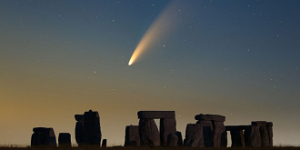 drama and its mystique, like the one revealed in the Neolithic monument Stonehenge (photo).
drama and its mystique, like the one revealed in the Neolithic monument Stonehenge (photo).
The times of pandemic made us more withdrawn both in the proximity of family members and in the interior life (which Western thought calls subjectivity), but where are we heading, what kind of Christmas this year will be, the end-of-the-year festivities we already know by the new pandemic wave will be reduced.
Anyway, we celebrate a passage, whether for Christians waiting for the parousia (the first two weeks) or from here to Christmas the intervention of God in history through the birth of the God-child in Bethlehem, which is gradually being erased from the party and replaced by consumerism, snow and other rites alien to the historical fact.
Yes historical, because Mary and Joseph go to Bethlehem precisely for a census, that is, to be counted among men and registered they should go to Joseph’s hometown and by a whim and divine care Jesus is born and is already registered among men, this is therefore not symbolic, but recorded historical data.
What to expect this Christmas, the atmosphere of “party” is reduced, we are still involved with the pandemic, there is a climate of apprehension and already a certain discouragement, for some it involves anxiety and some kind of anguish, nothing better than believing in a New weather, the popular saying goes: after the storm comes the calm, it will come.
Perhaps not as we expected, for example, a huge euphoria or an explosion of joy, but the feeling that we must rebuild life with struggle and behind the rubble, the Christmas season at its root is this, something divine intervened in human history to change it forever, it is certain that they want to erase Christmas and with it the hope of a new world, however precisely because of the suffering we have been through, we do not know how long it can last and how far it can go, it is a harbinger of a new time, a calm.
John the Baptist, who was Jesus’ cousin, baptized people with water (Baptist because of this), and the people thought he was the Messiah, but he explained that the type of baptism that would make Jesus would be much stronger: “He will baptize you in Holy Spirit and on fire. He will come with a shovel in his hand: he will clean his threshing floor and gather the wheat in the barn, but he will burn the straw in the photo that does not go out” says the evangelist Luke (Lk 3,16-18) and John “proclaimed a lot other ways” the Good News.
We can expect this in the near future, certainly yes, there is also this expectation in our theme, in many ways, and it will certainly be something unpredictable
History, the great clearing and parousia
Christmas is near and the birth of Jesus is a historical fact because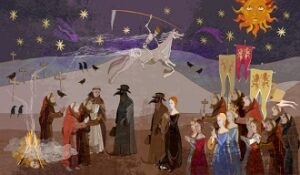 the Census ordered by the emperor of Rome Caesar Augustus, regarding the date there is controversy for it would be between 4-5 BC, when Quininus was Governor of Syria as described in the Bible (Lc 2.2), but it is certain that the census was carried out and this was precisely the reason why Mary and Joseph went to Bethlehem, where the prophecy said that from there the savior would be born, and thus he “was numbered among men”.
the Census ordered by the emperor of Rome Caesar Augustus, regarding the date there is controversy for it would be between 4-5 BC, when Quininus was Governor of Syria as described in the Bible (Lc 2.2), but it is certain that the census was carried out and this was precisely the reason why Mary and Joseph went to Bethlehem, where the prophecy said that from there the savior would be born, and thus he “was numbered among men”.
History is also punctuated by divine interventions, in the decadence of Rome the monasteries were born, where the culinary culture, the first guilds and offices and also an earlier stage of printed writing is carried out, through the copyists, the first schools and later the first universities, with a strong theological influence as it could not be otherwise, but this is all history, also in the renaissance art and culture had a strong influence (theological).
We enter modernity, the work that we read punctually in this week’s posts “all in the same boat” by Sloterdijk, mentions an important fact, in addition to citing the classic work of the Decamerão by Boccaccio as “small community in the midst of the big disaster” ( Sloterdijk, 1999, p. 75), makes an analysis of the Black Death (which happened in the 130’s) and which devastated Europe with more than 100 million people dead when the population was much smaller than today, and its political influence.
In a footnote he cites the work of Henrik Siewierki (translated by Estação Liberdade in 2001) “A mass for the city of Arras” where he analyzes the psychological and political consequences of the plague, also the psychologist Franz Renggli, in his book Self-destruction by abandonment , developed the hypothesis of the influence on modernity of the plague, and also of the degradation of the mother-child relationship that would have caused a kind of immunological, collective and psychosomatic weakness that favored the virus of that plague.
All this analysis is interesting in the midst of the Pandemic’s return to Europe, while it is undoubtedly a scourge, it can fuel a new clearing on our community, that is, the idea of a mutual and solidary defense in view of a catastrophe even greater than the one we’ve already encountered.
All this analysis is interesting in the midst of the Pandemic’s return to Europe, while it is undoubtedly a scourge, it can fuel a new clearing on our coimmunity (category of Sloterdijk), that is, the idea of a mutual and solidary defense in view of a catastrophe even greater than we have already encountered.
It serves to “make the paths smooth”, as the biblical reading says when John, the son of Zechariah and Elizabeth, announced in the desert using the words of the prophet Isaiah: “this is the voice of the one who cries out in the desert: ‘prepare the way of the Lord , make your paths straight’” (Lk 3,4) and it seems favorable to our time of scourge and desert.
It is important to remember that the first two weeks of Christmas celebrate not the coming of Jesus in Bethlehem, but the Parusia, that is, the preparation for his second coming.
The desert without inner life
Living only on the outside, projected onto the world, led to a special kind of anguish, anguish is an aspect of philosophy, one that is linked to the concept of emptiness, a certain type of philosophy and some forms of the concept “God is dead”, yes because there is another one, one of them is men try in vain to kill Him as if it were possible, as if it were possible to deny some intentionality in the creation of the universe, yes it can be multiverse, but also for it there must be an intentionality.
special kind of anguish, anguish is an aspect of philosophy, one that is linked to the concept of emptiness, a certain type of philosophy and some forms of the concept “God is dead”, yes because there is another one, one of them is men try in vain to kill Him as if it were possible, as if it were possible to deny some intentionality in the creation of the universe, yes it can be multiverse, but also for it there must be an intentionality.
The philosophical movement that gave voice to the feeling of “alienation and despair” came precisely from “man’s recognition of his fundamental loneliness in an indifferent universe”, the highlighted sentences are by Anthony Downs, an American political economist, who died in October of this year .
The reason why we must know the origin and development of certain concepts that seem just straw and without substance (because they are not observed in depth), is that they come to dominate a large part of contemporary life, such as the idealism that almost dominated all the isms of our time, including socialism and a certain type of Christianity (in picture the work of de Albert György).
The isms of our time are nothing but the rationalization of some form of idealism present in Descartes’ Western culture, passing through Kant to Hegel, his rejection based on the existentialism of Kierkegaard who insisted on the irreducibility of the subjective and personal dimension of human life, the existentialism took several forms, but it is the return to the question of Being and ontology that I consider an essential part of rediscovering the golden thread of the human spirit, or of the personal and subjective dimension as thought by Kierkegaard, part of an essential question that is “ because there is everything and not nothing”, and the nothing is clear is emptiness.
However, Kierkegaard also worked on the issue of anguish, which can be associated with emptiness or with the modern feeling of a form of alienation, his concept is different, it is the vertigo of freedom, advocated by modern man, it is through it that man feels repulsion and attraction, you can do anything, but not everything is convenient.
In “The concept of anguish”, Kierkegaard writes: “”a determination of the dreaming spirit (…) is the reality of freedom as pure as possible” (KIERKEGAARD, 1968, p. 45).
Soren Kierkegaard was born in Denmark in 1813 and had a life full of personal and family problems, in a space of twenty years he saw the death of two brothers and three sisters and then his mother, the disappointment in love with his fiancee Regina Olsen culminates in his own life what it expressed in philosophy.
The concept of anxiety became central in the development of existentialist philosophy, it is present in Heidegger, Jaspers and Sartre, but it has not been left out in previous philosophies such as Husserl’s phenomenology and rather in Franz-Brentano’s social psychology.
It is Heidegger who makes the issue of anguish a problem of everyday life, writes: “The being-to-death is, essentially, anguish. This is undoubtedly witnessed, although “only” indirectly, by the already-characterized para-to-death being, at the moment when anguish becomes a cowardly fear and, overcoming it, denounces the cowardice of anguish. (HEIDEGGER, 1998, p. 50).
Therefore, for Heidegger, anguish is an existential determinant and it manifests itself in the daily life of being-in-the-world, in the words of Hanna Arendt, it is a “human condition”.
The issue comes up again because of the pathological form it took in the Pandemic, precisely the deprivation of freedom, see that Kierkegaard’s concept makes sense.
Heidegger, M. The Origin of the Work of Art. In: Forest paths (Holzwege). Lisbon: Calouste Gulbenkian Foundation, 1998 (in portuguese).
Kierkegaard, Soren. The Concept of Anguish. Lisbon: Hemus editora, 1968 (in portuguese).
Form and act
Information is a strong word at this time in history, however the concept of form of in-form seems to be separate from the concept of matter, hylé for the Greeks.
the concept of form of in-form seems to be separate from the concept of matter, hylé for the Greeks.
Modern philosophy has separated form from content, as well as separating a label from the ingredient in a bottle, but this comes from the reduced understanding of what matter is, the hyle of the Greeks, whose thinking in Aristotelian terminology interconnects them in hylemorphism ( ὕλη, hýle = “matter”; μορφή, morphé = “form”) and in-formation is that.
For this to have an anthropological reach, necessary for the discourse of cultural diversity, it is necessary to link act and potency, as Thomas Aquinas did, where matter is not what we call today (as substance, for example), but what it is as a possibility or in potentiality, written like this by Thomas: “matéria est id quod est in potentia” (matter is what is in potentiality) (THOMÁS, ST I q.3 a.2 c).
Thus the act is the actual existence, or the acting itself, that is, “forma est actus (form is act) (ST I q.50, a.2, obi.3).
Thus, the articulation of the binomials potency x act and matter x form in this way, “matter is nothing but potency, since form is what something is for, as it is the act” (TOMÁS, ScG II, c.43), these categories they give a distinction from fundamental metaphysics, and anthropologically they mean that one thing is the possibility of existing or acting: potency or matter, something else is actually existing or acting: act or form.
Some modern theologies want to separate body and soul, that is, without eschatological and biblical foundation, otherwise the human figure of Jesus would be divided into two: the divine and the human, which would be in opposition and fight against each other, and that is why the Christian anthropology must be strictly unitary, as it is in Thomas Aquinas.
The existence of a body in the human condition is the union between power and act, between matter and form (seen in this new aspect linked to content and essence), without its actual existence (form) the body would not even exist , but only the possibility of existing (potentially) makes it exist in act, this unity is radical, since the necessary condition for its existence is the body. this is fundamental to understand the Christian anthropology written clearly by Thomas: “The human being is not just soul, but something composed of soul and body” (THOMÁS, ST I q. 75 to 4c), if on the one hand all materialism (which is not hylemorphism) denies the existence of the soul, a lot of bad theology seeks to deny the existence of the body, it is the modern dualistic relationship, crystallized in objectivity and subjectivity, in which both are mutilated.
According to Thomas Aquinas, human living bodies and actual existence (form, also called by him the intellective soul) is immortal, unlike other non-human living bodies, whose existence has a beginning and an end, not an eschatological end, but the finalist end of an interruption, for all humans die, and for him death is explained as a temporary deficiency through which we pass into immortal existence and overcome the radical deficiency of the living body through death.
Put more clearly: “That the soul remains after the body, this happens because of a deficiency of the body [per defectum corporis] which is death.
THOMAS AQUINAS. Theological Summa São Paulo: Loyola, 2001-2006. 8 v.
The cry of the afflicted
In many moments of personal difficulties, world conflicts and natural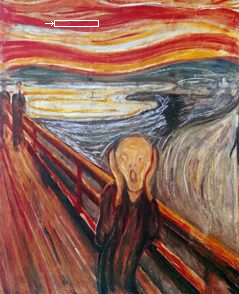 tragedies, there is always an apparent cry of despair and pain, but our time is a silent cry for those who lose their reason for living, the pandemic has also caused many anguish, loneliness and despair.
tragedies, there is always an apparent cry of despair and pain, but our time is a silent cry for those who lose their reason for living, the pandemic has also caused many anguish, loneliness and despair.
The famous pcitura Norwegian Edvard Munch’s The scream represents an androgynous figure in a moment of deep anguish and despair, with the Oslo fjord at sunset in the background, characterizes well what affliction means in our time, in addition to misery and lack of solidarity , the anguish and anxiety of the figure may be the author’s own, the phrase written at the top of the painting: “it could only have been painted by a madman”, analyzed by the Oslo National Museum concluded that it was the author’s.
The aspect of anxiety would remain veiled, were it not for this analysis, since the author stated on one occasion: “I have suffered a deep feeling of anxiety that I have tried to express in my art”, and this reflects our contemporary fears.
GAD (Generalized Anxiety Disorder) is one of the symptoms of this condition, which can also be bipolar or some other type of lack of control, this type was generically called Neurotic Anxiety, but there are two others: Realistic and Moral.
Realistic anxiety refers to the fear of something existing in the outside world, so a pandemic or a natural catastrophe (hurricane, earthquakes, sudden changes in climate, etc.) is basically a kind of fear of something real happening but that puts us in a different adrenaline.
Moral is the one that refers to the feeling of guilt, which triggers a fear of being punished, and this leads to a situation of conflict in the interior, so the person loses sensitive aspects of their interior: the unconscious threatening to enter the conscious what it means in practice a loss of self-control.
But the afflicted are also the helpless, the abandoned and the rejected by society, the various types of prejudices on which current controversies are born.
In the Christian reading, the text of Matthew (5:4) although some translations put as “afflicted”, the translation we prefer here: “Blessed are those who mourn, for they will be comforted!”, because beyond the aspect of “sickness “there is structural evil and social evil that push many people into this state, and blaming them just means adding to any kind of “affliction” the neurotic anxiety that is born of a disproportionate sense of guilt, and this is the great kind of current social pressure.
But what would be the comfort the bible speaks of, the comfort of those who believe is that the only evil they should fear is the soul, so contrary to what many moralistic interpretations say, it is a balanced morality and without the exaggeration of guilt that it leads to an inner state without this kind of anxiety.
The meekness in times of polarization
Meekness is a fundamental virtue for resolving conflicts, establishing new spaces for dialogue where it ended and opening new horizons where they seem impossible.
establishing new spaces for dialogue where it ended and opening new horizons where they seem impossible.
John Calvin has a very noble phrase: “It will be useless to teach meekness unless we have started with humility”, in fact the great reason why some seem right and others unreasonable. on the sides (the opposite of humility) and within these parameters, no dialogue will be possible, or what we prefer, no “new horizon” will be drawn that establishes a future point where conflicting points may enter into a process of convergence.
Polarization is inevitable may be the arguments of some, yes if reaching a certain point of conflict this is valid, but we must know that the actual way out of a conflict will have to have the flag of peace at some point and it cannot be the The flag of submission of the vanquished, the pax Romana, after Rome conquers its territories, it is submission to an authoritarian concept that at a certain point will return to war.
Power is always asymmetrical, this is true, but meekness can lead to it being exercised with modesty and justice.
Polarization is logic may be the argument to justify it, but remember that fuzzy logic, paraconsistent logic and other logics are not binary, yes or no, and that there are never only two sides, this is an idealistic position that it induces duality, there can be multiple sides, so the really fair logic admits a third hypothesis.
These will never be winners and will always be by the wayside may be another thought, as paradoxical as the divine teaching may seem, in many religions, is that meekness and humility lead people to high, one of the biblical beatitudes says (Mt 5, 5): “Blessed are the meek, for they will possess the land” and so where is their power, the conquest through perennial values can only lead to plenitude and perenniality itself, the problem is to yield to values tricky and unfair.
The construction of a perennial reality, a time of peace and justice, as we begin to emerge from a pandemic, is fundamental, even if it seems distant.
The divine environment and the human phenomenon
Chardin’s worldview on the human phenomenon ranges from cosmogenesis, the origin of the universe and of life to the complexification of nature and the place of man in it, what the pandemic shows is that this complexification grows and even science has limits to deal with it, however, this pandemic can bring new horizons, when it thinking and clarifying it needs science.
cosmogenesis, the origin of the universe and of life to the complexification of nature and the place of man in it, what the pandemic shows is that this complexification grows and even science has limits to deal with it, however, this pandemic can bring new horizons, when it thinking and clarifying it needs science.
Among his various works, Teilhard Chardin makes a singular journey between The divine environment, written between November 1926 and March 1927 and the Human Phenomenon, written between July 1938 and June 1940, which form an “inseparable whole” also says edition I have of Editorial Presença de Lisboa, Portugal.
Singular because it transits from the divine to the human, as the names of the works attest, without slips or ravages, it shows us the “need for the connection between science and religion equally affirmed by Einstein”, an expression by Helmut de Terra, friend and admirer of Chardin. Chardin initiates the divine environment by realizing “the confusion of religious thought in our time” (page 41) and attests that the man of our time “lives with the explicit awareness of being an atom or a citizen of the Universe” (idem).
The timeliness of the text is because the author affirms at the beginning of his book something that has a lot to do with our days, a collective awakening that a beautiful day “makes each individual aware of the true dimensions of life, necessarily provokes in the human mass a profound religious shock, both to slaughter and to exalt ”(ibidem).
This is because the world is too “beautiful: it is to him and only to him that they should worship” (p. 42). What is then the “divine environment”, the world (in our case we explore the universe’s worldviews) will not be more and more fascinating and it would not be and it would be “eclipsing our God” (idem), and there is a connection, in the view of part of Christianity, between God and matter, the Eucharist, she and she alone can create a real sense of reconnecting us to the divine, “this is my body and my blood” said Jesus, and those who eat will have access to eternal life.
Chardin says “the slowly accumulated tension between Humanity and God will reach the limits set by the possibilities of the World, and then it will be the end” (p. 177)… that we must wait not as a catastrophe but as an“ exit ”to the world to which we must collaborate with all our Christian forces without fear of the world, because his enchantments could no longer harm those for whom he became, in addition to himself, the Body of the One who is and the One who comes ”.
Chardin, Teilhard. (no year). O meio edivino: ensaio sobre a vida interior (The divine environment: I teach about the inner life). Lisbon: Editorial Presença.
Man’s place in nature
Edgar Morin we’ve already done some posts here. However, we want to dialogue with the anthropocentric concept that dominates many studies and increasingly we see that it is a limitation since nature has its own course, and the brutal interference of man can modify and harm this course.
want to dialogue with the anthropocentric concept that dominates many studies and increasingly we see that it is a limitation since nature has its own course, and the brutal interference of man can modify and harm this course.
According to Ways (1970) cited in Chisholm (1974) there is a tendency in Western epistemology to objectify nature to see it “from the outside”, and this is responsible for the arrogant and insensitive way of dealing with the natural world, according to the author’s own attitude of separation of man from nature constitutes the basis of the growing human knowledge of nature, being, therefore, an anthropocentric interpretation of the evolution of the natural world.
On the other hand, the complexification of nature in man is undeniable, as an animal that is aware, or in other words aware of its own conscience, which can lead to another extreme, which is the “internalization” where culture and nature are confused , where subjectivism can be a responsible trend for this aspect.
The paleontologist Teilhard de Chardin, in his work “The Human Phenomenon”, observes that there is no anatomical or physiological trait that distinguishes man from other higher animals, on the other hand, it has the zoological characteristic that makes it a being apart in the animal world. , is the only one that inhabits the entire planet, another characteristic that comes from its form of consciousness is its organization as consciousness and thought structure, which Teilhard de Chardin calls “noosphere”, a sphere of thought that is also world-wide.
As for man, it remains to be seen, and even science does not know, if it is a mere superficial accident that has happened or if there is an intention in him since the Universe was created, whether Big Bang or not, reflects Teilhard Chardin: “that we should consider it – about to sprout from the smallest fissure anywhere in the Cosmos – and, once it has arisen, unable to waste all the opportunity and all the means to reach the extreme of everything it can reach, outwardly of Complexity, and inwardly of Consciousness” (CHARDIN , 1997).
CHARDIN, T. (1997) Man’s place in nature, trans. Armando Pereira da Silva, Ed. Instituto Piaget, Lisbon.
CHISHOLM, A. (1974) Ecology: a strategy for survival. Rio de Janeiro: Zahar.
The plague, the truth and blindness
There comes a time when resigning oneself to the disease and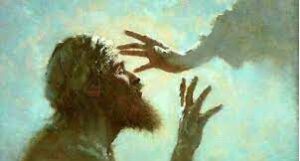 not setting new paths is also cowardly, says Camus in his chronicle The Plague: “But there comes a time in history when he who dares to say that two and two are four is punishable by death”, as it is “…an idea that might make you laugh, but the only way to fight the plague is honesty”.
not setting new paths is also cowardly, says Camus in his chronicle The Plague: “But there comes a time in history when he who dares to say that two and two are four is punishable by death”, as it is “…an idea that might make you laugh, but the only way to fight the plague is honesty”.
Overcoming fear, and for many the pain, “I understood that all the misfortune of men came from not having a clear language. So I decided to speak and act clearly, to put myself on the right path.” This implies not only wisdom and courage, but also overcoming human blindness.
Thus: “From the beginning of history, the scourges of God have placed the proud and the blind at his feet. Meditate on this and fall to your knees”, and in the present case, a tiny virus brings all human wisdom and intelligence to its knees, so that they are not allowed to admit the infinite, the Love and the presence of a mystery in life.
Camus saw this not in a religious way, but in a true way: “The evil that exists in the world almost always comes from ignorance, and good will, if not enlightened, can cause as much harm as evil. Men are more good than bad, and that’s not really the point. But they are more or less ignorant, and this is what is called virtue or vice, the most desperate vice being that of ignorance, which thinks it knows everything and is then authorized to kill”, but hatred and war are waged.
The biblical figure of the blind Bartimaeus is very illustrative of human blindness, but this blind man was aware of his limitation, when he knew that Jesus approached him, he shouted for him to have pity on him, the apostles were bothered, but Jesus will ask, he shouted (Mk 10 :48-52): “Son of David, have mercy on me” Then Jesus stopped and said, “Call him.” They called him and said: “Courage, get up, Jesus is calling you!” The blind man threw off his robe, jumped up and went to Jesus. So Jesus asked him, “What do you want me to do for you?” The blind man replied: “Master, let me see! Jesus said, “Go, your faith has made you whole.” Instantly he regained his sight and followed Jesus along the way”.
The awareness of Bartimaeus’ blindness moved him, and the desire for cure bothered him even more, he who thinks he sees and sees everything in the shadows is blinder than Bartimaeus and as an excerpt from the chronicle The Plague says: “they denied, at last, that we had it was that people stunned that every day one share, piled up in the mouth of an oven, evaporated in greasy smoke, while the other, laden with the chains of impotence and fear, awaited its turn”.
Mass culture and its criticism
In Morin’s book “The Mass Culture of the Twentieth Century”,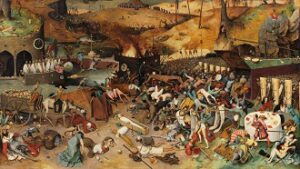 it is stated that there is a zone “where the distinction between culture and mass culture becomes purely formal: The Human Condition, Nausea or The Plague enters the culture of mass without, however, leaving the cultivated culture” (Morin, 1997, p. 53) and Camus’ book is interesting for its coincidence with the issue of the current Pandemic, and interesting that it did not enter into the analysis of the cultural aspect of the moment.
it is stated that there is a zone “where the distinction between culture and mass culture becomes purely formal: The Human Condition, Nausea or The Plague enters the culture of mass without, however, leaving the cultivated culture” (Morin, 1997, p. 53) and Camus’ book is interesting for its coincidence with the issue of the current Pandemic, and interesting that it did not enter into the analysis of the cultural aspect of the moment.
We have already posted on the blog at another time about Camus’ book “The Myth of Sisyphus” and oher about José Saramago’s novel Essay on blindness (1995), although widely read in some European countries amidst the pandemic, his analysis was not entered the circles of cultural “high narrative”, that we tried to explain in some posts this week.
Written in 1947 by the weak Algerian Alberto Camus, its origin is important, because its chronicle starts from an analysis of an epidemic that occurred in the Algerian city of Oran, in some year of the 1940s, when Camus worked clandestinely in the clandestine newspaper “ Combat!” where he wrote texts engaged against Nazism, among them “Letters to a German Friend” (1945) stand out.
The book deals with the absurdity of existence, when in the midst of an epidemic there is a lack of love and human solidarity, whose feelings can be summarized where he wrote: “There were common feelings, such as separation or fear, but the personal concerns.
No one had yet truly accepted the disease”. Another excerpt that can be highlighted: “Many continued to hope that the epidemic would cease and that they, with their families, would be spared. As a result, they still didn’t feel obligated to do anything.
The plague was nothing more to them than an unpleasant visitor who would one day depart. Frightened but not desperate, the moment had not yet come when the plague would appear to them as the very form of their life and when they would forget the existence they had been able to lead until then.”
With the war just over in the period that he wrote the book, he remembers: “The scourges, in fact, are a common thing, but it’s hard to believe in them when they befall us. There were an equal number of pests and wars in the world. And yet, plagues, like wars, always find people equally unprepared.”
He shrewdly analyzes the scourges in history: “From the beginning of history, the scourges of God have brought the proud and the blind at his feet. Meditate on this and I fell to my knees.” and adds: “Oh, if it were an earthquake! A good shake, and there was no more talk about it… counting the dead, the living, and that was it. But this damn disease! Even those who don’t catch it seem to carry it in their hearts.”, and his conclusion brings a reflection: “The more the pandemic spreads, the more the moral will become elastic.”
I understood that the absence of solidarity and compassion, as well as the elasticity of morality were not unusual facts in epidemics, but somewhat expected, but I would add that there is always a more humane, more solidary alternative that gives us the hope of a much more just after a sad scourge, learn something from it.

